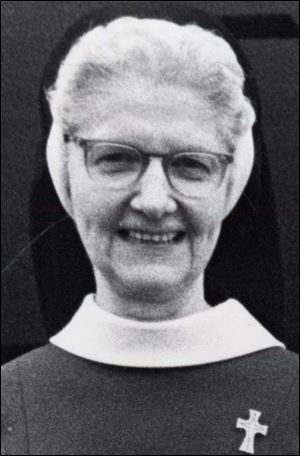
COMMENTARY
Robinson’s death closes a chapter, but not the book
7/12/2014

Sister Margaret Ann Pahl was once known as Sister Mary Annunciata, but she reclaimed her family name after Vatican II. Born in Edgerton, Ohio, in 1908, she entered the Sisters of Mercy religious order at Our Lady of the Pines in Fremont when she was 19. She remained a nun for more than 52 years.
When she was 26, she graduated from St. Rita's Medical Center in Lima as a trained nurse and began a hospital-oriented career. After serving as a nurse in hospitals in Ohio and Michigan, she became a nursing supervisor in Tiffin. Then she moved to Toledo in 1954 to be a supervisor at St. Charles Hospital, then after five years an administrator. In 1962, she was director of nursing service at Mercy Hospital in Toledo, and for the next decade she held that position at the hospital where she was trained in Lima and at Our Lady of Mercy Hospital in Coldwater, Ohio.
In 1971, the year she turned 63, her hospital work shifted from medical to pastoral care, and she was the main sacristan, in charge of the sacred items for the two chapels in Mercy Hospital on Jefferson Street.
Sister Margaret Ann's life ended a day before she was to turn 72, which was also a day before Easter. It was a hospital death, but not one of care and comfort surrounded by doctors, tubes, machines, and family. Sometime between 6:45 and 8 a.m. on April 5, 1980, she was strangled and stabbed 31 times in the sacristy of St. Joseph's Chapel, on Mercy's first floor. According to prosecutors and a jury, there was one person present at her death, the hospital chaplain—but the chaplain was her murderer, the Rev. Gerald Robinson, 41 at the time.

Pahl
Sister Margaret Ann was an “old school” nun who “demanded everything to be done exactly as she wanted it done, and on time,” a detective wrote after interviewing another sister. Did her old-school ways lead to her death?
The story of Sister Margaret Ann and Father Robinson, of a nun killed by a priest, will now fade, after 34 years. My predecessor as Blade religion editor, David Yonke, covered the story extensively, and other Blade staff contributed. Our courts reporter, Jennifer Feehan, kept tabs on Father Robinson's recent legal efforts.
Father Robinson was suspected in 1980, but he was not arrested until 2004, after cold-case investigators reexamined the details; they even exhumed Sister Margaret Ann's body from St. Bernardine Cemetery in Fremont after Father Robinson‘s indictment. Father Robinson was convicted in 2006, sentenced to 15 years to life, and died in a prison hospice at age 76 on July 4.
Father Robinson had been restricted from public ministry, but he remained an ordained priest because he appealed the conviction. All appeals have stopped now, with his death, and will not be ruled on.
The diocese's director of communications, Sally Oberski, told me in an email that, had the appeals been denied, “action would have been taken with the Congregation for the Doctrine of the Faith in Rome to take the steps toward his status as a priest.” In Tuesday’s Blade I wrote that action would be taken to remove him from the priesthood, but Miss Oberski clarified that “status” was more appropriate. The Toledo diocese and the Congregation for the Clergy would also have been involved. Ordination is a burden not easily lifted from a minister.
The diocese chose to recognize Father Robinson’s priestly status for Friday’s funeral at St. Hyacinth Church. The Survivors Network of those Abused by Priests and the National Survivors Advocacy Coalition objected to that decision and sent a letter to the Rev. Charles Ritter, the administrator of the Diocese of Toledo during this interim period between bishops. Voices of the Faithful also wrote to Father Ritter, emphasizing that honoring the priestly status of Father Robinson did not show concern for Sister Margaret Ann or for other victims of clergy abuse.
The diocese did not give “full honors” like most deceased priests receive, but it had planned to put a priest's stole on his casket and have special prayers for priests. He wasn‘t buried in the cemetery’s priests‘ section.
The Sisters of Mercy South Central Community made a public statement that “many painful memories” were rekindled but showed their mercy, saying, “God's grace empowers us to forgive the person who caused her death and created great suffering among us. We rely on the compassionate love of God and the love of others to continue to heal us and to bring peace to all who have experienced such tragedies.” Lee Pahl, a nephew of Sister Margaret Ann, made a statement that the Pahl family forgave the murderer, following their religious tenets, soon after the murder, before they knew who was the killer.
There seems to be one advantage to the timing. Toledo has had three bishops since Sister Margaret Ann died. For the next one, who could be named by Pope Francis at any time, Father Robinson will be only bad news from the past, not a continuing concern.